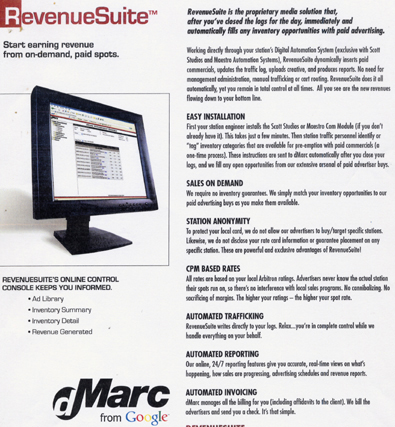Google $20 billion radio chatter

Google CEO Eric Schmidt has a special personal interest in the Google dMarc Broadcasting radio play; Schmidt hopes Google’s "targeted, measurable advertising," via car radio, will steer him in the right direction when “he needs a pair of pants,” as I recounted last June in “Google targets GPS-based in-car personalized advertising”:
Eric Schmidt, Google CEO, believes that when he is listening to the radio in his car, radio ads should personally address him about his needs. For example, while driving past a clothing store, a radio ad should remind Eric that he needs a pair of pants and instruct him to turn left at the upcoming clothing store.
Schmidt put forth his vision for GPS location-based delivery of highly targeted and personalized advertising via in-car radios at a NYC luncheon with publishing executives and predicted a realization of his vision within one to two years, but he did not provide his vision for how the Google owned dMarc Broadcasting, a "digital solutions provider for the radio broadcast industry," would enable such digital ad delivery via car radios.
Since Schmidt’s forward-looking radio advertising prognostics, I have been tracking and unearthing Google dMarc progress; not only is the $20 billion radio advertising market in play, Dr. Schmidt may soon be on a pants shopping spree!
Given Schmidt’s keen interest, and $100 million plus investment in, the Google radio advertising forays, I was particularly struck that not a word was said of dMarc at the company’s Q3 conference call and asked Google shortly after about the real status of its dMarc radio plans as I report in “Google $20 billion radio ads: Not a test!” and “Google: Radio star or bit player?”
Google told me that the company aims to roll out a Google Audio Ads beta product for marketplace introduction by the end of the year. The Google radio ad product has been in a testing phase since the summer (under a different name), as I reported in July in “Google AdSense for Radio: Google diversification win?”
Google hawked the dMarc Broadcasting system at the “NAB Radio Show” in September:
Google touted many capabilities at the “most important week in radio”Google’s automation systems, SS32 and Maestro, provide the industry’s greatest power, flexibility and stability, and connects advertisers and agencies directly to radio stations with a robust advertising platform that automates sales, scheduling, delivery and reporting. Result: greater control over quality and operating costs with maximum revenues and accountability.
Broadcast & Production Facilities Installation, Digital Audio Broadcasting (DAB), Internet/Online Services, Radio Automation Systems, Radio/Audio
Below is a data sheet on a Google dMarc product: RevenueSuite

RevenueSuite from dMarc Broadcasting is described as an:
Exclusive service for Scott Studios and Maestro customers that helps stations maximize their revenue potential by turning unsold inventory into bottom-line profits. RevenueSuite’s patent-pending service automatically accesses last-minute, remnant avails and dynamically inserts paid commercial spots directly through the station’s Digital Automation System, allowing the station to share in a new source of advertising revenue.
Over the past few months, Google has changed the name of its projected radio advertising product and has revised its marketplace launch date.
In August, Google announced a deal with XM Satellite Radio to “deliver targeted advertising to satellite radio listeners.”
In “Google: Radio star or bit player?” and “SWMX Radio vs. Google? SWMX COO talks ‘The Real Deal’ in exclusive interview” I discuss the industry chatter on diverse market strategies of interest to Google dMarc, such as:
Large scale recruiting of well connected radio execs for a roll-out in the major markets,
Large scale investment in high quality radio ad inventory.
Google has let it be known loud and clear that it seeks to dominate the offline advertising world—print, radio, tv—as I underscore in “Google failing to snag $116 billion print, radio, television ad markets.”
Google recently embarked on its fourth time at bat in the print world, see “Google’s $48 billion Print Ads test: Fourth time’s the charm?”
Google can not afford to strike out with its dMarc Broadcasting ambitions.